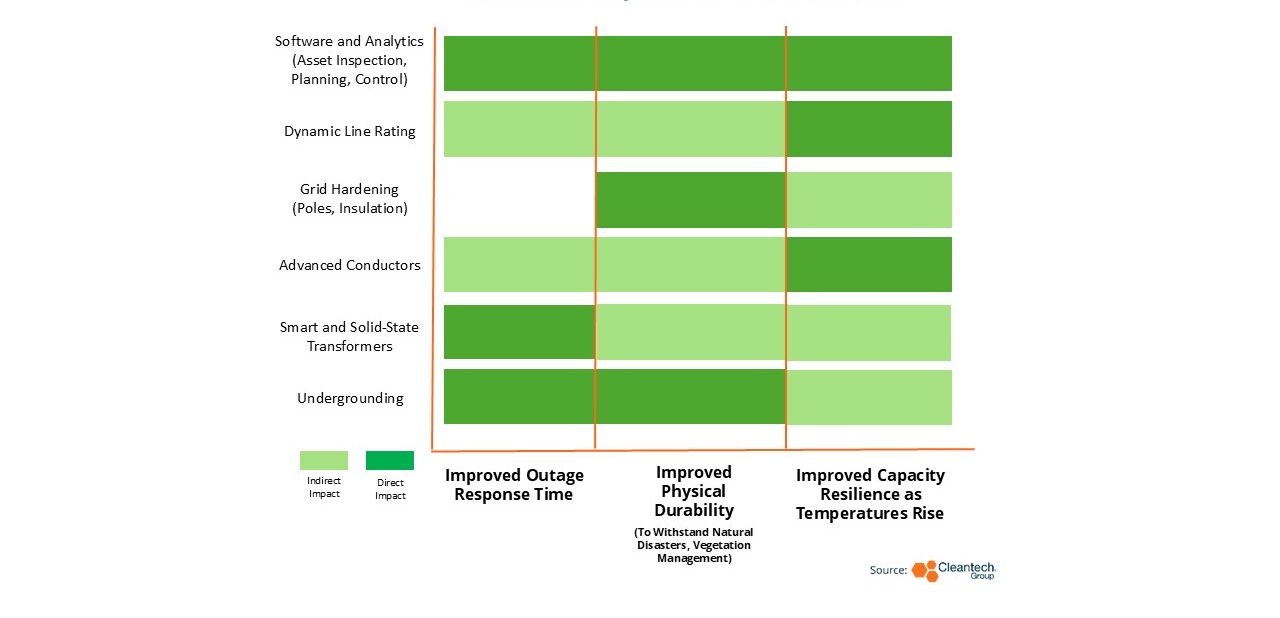Technologies Improving Grid Resiliency are Needed to Respond to a Changing Climate
According to Climate Central, between 2000 and 2023, 80% of all U.S. power outages were due to weather-related events. Additionally, it was recorded that there were at least two times more weather-related outages in the latter half of the decade (between 2014 and 2023) than the first 10 years (2000-2009).
As governments, corporates and utilities think about needs of the grid, from increasing transmission, to strengthening infrastructure and replacing aged assets, it is also imperative to think about what solutions will allow the grid to operate more efficiently as temperatures and climates change.
Outages can cause significant disruption and major economic losses with the potential to substantially impact livelihoods as well. Electricity is used to heat and cool homes, refrigerate food for restaurants, power hospitals and other life-supporting equipment, and power manufacturing lines to produce consumer goods for sale.
Any disruptions, brown outs, or black outs will have significant human impact and financial losses. Insured assets are also at stake and insurance agencies will need to better understand the data related to outages and the solutions that can prevent and respond to these outages to better determine costs associated with coverage, payouts, and risk management.
Various environmental and climate factors can affect electricity use and grid outages. Rising temperatures can increase thermal sag on conductors with the potential to cause wildfires. Simultaneously, the additional demand for air-conditioning and cooling can put a greater strain on the grid causing black outs. Other weather events such as strong winds, lightning, ice storms, earthquakes, and flooding are also causes behind downed power lines and black outs.
As a result, utilities, corporates, financial institutions, innovators, and governments will need to collaborate and adopt additional technologies and tools that will strengthen grid infrastructure assets, reduce the frequency of outages, improve response times and re-route power when lines go down, and support systems that will better withstand higher temperatures.
Resiliency Solutions
Grid modernizing solutions must be de-risked and deployed to improve grid reliability and reduce congestion costs.
Technologies Improving Grid Resiliency

Sample Companies Providing Resiliency Solutions
Grid Hardening and Strengthening Physical Assets. Solution providers like RS Technologies and GridWrap leverage composite materials and poles to support grid systems and wires. Composite poles and structures can mitigate impacts of extreme fire and storm events. GridWrap is also developing a solution to support wires using drones that can enhance transmission capacity.
Advanced Conductors. Traditional steel core wires can sag as temperatures rise increasing the risk for outages and wildfires. In addition to providing substantial transmission capacity improvements (up to 50% to quadruple the transmission capacity depending on how they are implemented), advanced conductors can also offer better material properties and maintain efficient operations in temperatures up to 200°C. This is crucial as temperatures begin to rise in different parts of the country.
While the benefits from improved transmission are important in reducing the duration of outages, the value advanced conductors have from a transmission perspective will also make them more economical to implement and leverage the resilience benefit. However, certain estimates by the U.S. Department of Energy and Idaho National Laboratory suggest that there may only be limited regions in the U.S. where advanced conductoring is feasible. Many aging systems still require new builds. However, advanced conductors have steadily been gaining traction with utilities and other customers.
CTC Global has been selling their ACCC conductor with a hybrid carbon and glass fiber core for some time. They have projects with over 300 utilities and customers in over 66 countries.
TS Conductor, a portfolio company of Breakthrough Energy Ventures and National Grid Partners, has been actively partnering with utilities to implement their conductors. In addition to conductors that provide enhanced transmission capacities, they can also provide better data management as carbon fiber components are integrated into their conductors to provide real time data. The company has been partnering with entities to ensure various financing mechanisms can be used to enhance deployment.
Another branch of technologies to look out for includes high temperature superconductors. While still in the early stages of development for grid applications, high temperature superconductors are beginning to rapidly commercialize now based on demands from the growing fusion industry.
VEIR, a company that looks to integrate high temperature superconductors into the grid, claims that their conductors could potentially provide 5 — 10 times greater transmission capacity improvements. In addition to providing an entire step change of improvement from a transmission standpoint, VEIR conductors can also operate in high temperatures using their innovative nitrogen cooling process that cools the wires.
Resilience requires grid infrastructure to withstand extreme weather events and increasing temperatures while improving recovery from disruptions. Estimates suggest grid infrastructure will have to double or triple in capacity to address growth in electricity demand (EVs, heat pumps, data centers, manufacturing, etc.) and new renewable generation. Technologies like these can improve grid resiliency substantially and help the fight against increasing temperatures, extreme weather events, and aging grid infrastructure.
Anthony DeOrsey and Selene Law of Cleantech Group discuss Distributed Energy Resource (DER) management- the current trends and possible future technology.



